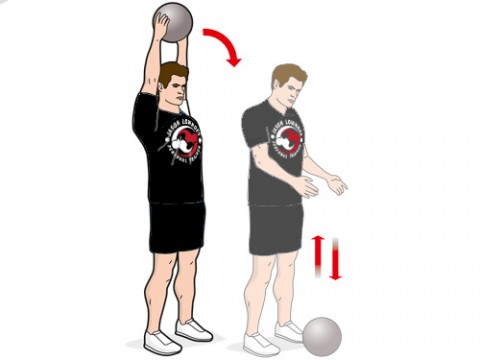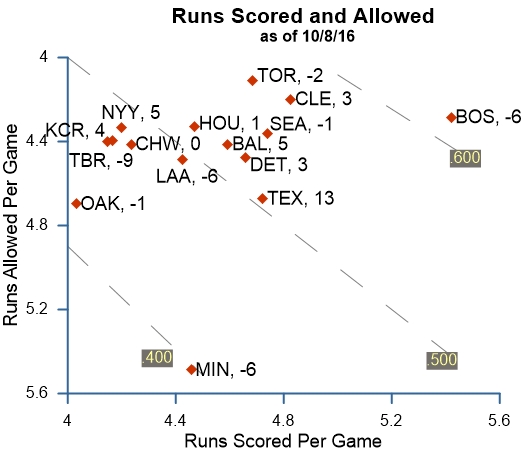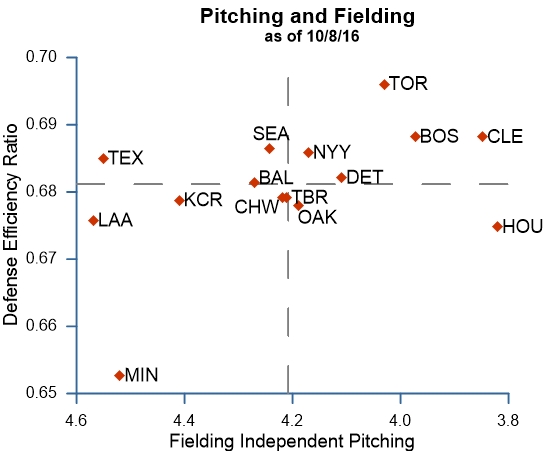.
A couple of days ago, Dave Studeman published us the kindsa charts we likey. This one plots the quality of your favorite team, which had better not be the Texas Rangers:
.
.
You notice the dashed line that runs from top left to bottom right. All .500 teams would be on this line, if all bases gained were equal. The .500 teams that won abd lost their games 3-1 -- like Daddy-O's 1964 Dodgers (80-82) we presume -- would be very top left.
The .500 teams that won and lost their games 13-9 -- like the 2010 Colorado Rockies, keyed by Miguel Olivo but also including Olivo's supporting cast, Tulowitzki, Helton, and Seth Smith, would be very bottom right.
A team is worse as it moves toward the bottom left corner. It's better as it moves to the top right. It's more boring and cruddy and mediocre as it moves toward the Texas Rangers in the middle. (Earlier we asked for an example of a team that moved from perfectly center to top right based on luck....)
......
When you don't have facts and data to back your opinion, there's nothing wrong with reaching for the "imagination and baloney" spice rack. Forthwith: it's a little surprising to me that the Mariners' "run prevention model" had more to do with their success than their trifecta of 100-RBI men in the middle of the lineup. Also, The Hardball Times doesn't have much bad to say -- er, not much bad to depict -- about the Mariners' glovework:
.
.
THT had the M's "neutralized" pitching as just about average, and their out conversion #4 in the league. In part, no doubt, due to Safeco.
.
TALKING POINTS MEMO
(1) Re-roll the dice for the 2016 season and the Seattle Mariners are clearly the best team in the AL West per this metric. Not the best team by a large margin, but the best team by a clear margin.
(2) You could separate the AL teams into four strata:
a) Three teams that were well above average for both run scoring and run prevention. The division winners.
b) Seattle, comfortably past the dashed line in all vectors. As they have been since 1977, pretty much.
c) Four teams slightly past the dashed line - Bal, Det, Hou, and Tex.
d) The lousy teams.
(3) DiPoto's "transition" season created an all-around "solid" team that finished 86-76. A couple of games short, but it beats 61-101. We broke a 15-year run of meaningless games in the last week of the season.
.
DR's DIAGNOSIS
DiPoto last winter said gracious things about almost everything, and he bent over backwards to avoid cleaning out Zduriencik's players the way that Jack Zduriencik made it such a point to clean out Bavasi's players. He did say a few things, though, about rotten spots in the woodwork that left him aghast.
From Dr. D's standpoint, this included players left to their own devices in hitting and training, the inmates running the asylum, relievers selected for fastball velocity rather than for effectiveness, doghouses and petted favorites, lawyer intervention, and so forth.
In one winter, DiPoto did indeed change all that. He's got his layering, he's got his culture, he's got his depth and his approach. He's got the minors being voted on for best in the bidness. This winter, he'll be "running downhill" or "throwing downhill" or whatever GM's do when they've got the booster rocket off the ground; hey, if Steve Raible doesn't know what it means to run downhill, I don't see why Dr. Detecto has to explain it in any great detail.
Next step would logically be to address the top of the roster, to add impact to the depth. And that's what he's implied. Let's see a couple of those 3-for-1 blockbusters. I dunno that Taijuan and ? is out there for Corey Seager, but that's what we'd be thinkin'.
Enjoy,
Dr D


